- Back to Home »
- Why you won't die in a plane crash
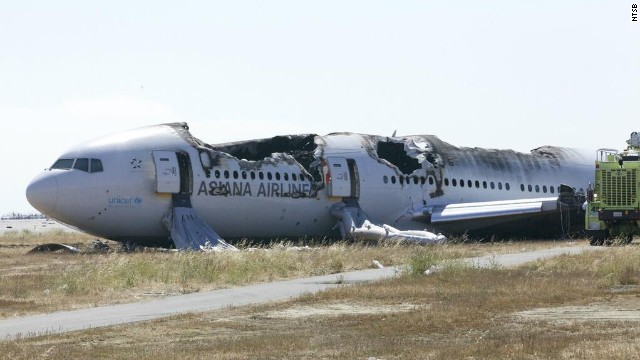 Asiana Airlines Flight 214 sits just off the runway at San Francisco International Airport on Sunday, July 7, in a handout photo from the National Transportation Safety Board. The Boeing 777 coming from Seoul, South Korea, crashed on landing on Saturday, July 6.
Asiana Airlines Flight 214 sits just off the runway at San Francisco International Airport on Sunday, July 7, in a handout photo from the National Transportation Safety Board. The Boeing 777 coming from Seoul, South Korea, crashed on landing on Saturday, July 6. 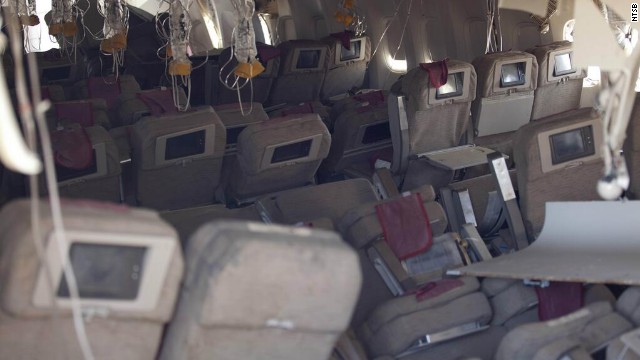 On July 7, the NTSB released this photo showing the inside of the aircraft.
On July 7, the NTSB released this photo showing the inside of the aircraft. 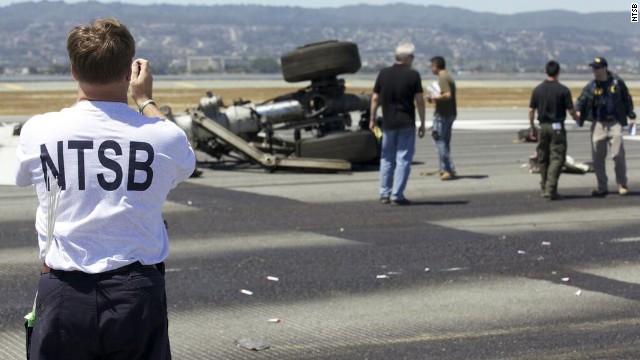 An investigator photographs part of the landing gear at the crash site in a handout released on July 7. The NTSB's preliminary assessment of the plane's cockpit and flight data recorders shows the flight was coming in too slow and too low.
An investigator photographs part of the landing gear at the crash site in a handout released on July 7. The NTSB's preliminary assessment of the plane's cockpit and flight data recorders shows the flight was coming in too slow and too low. 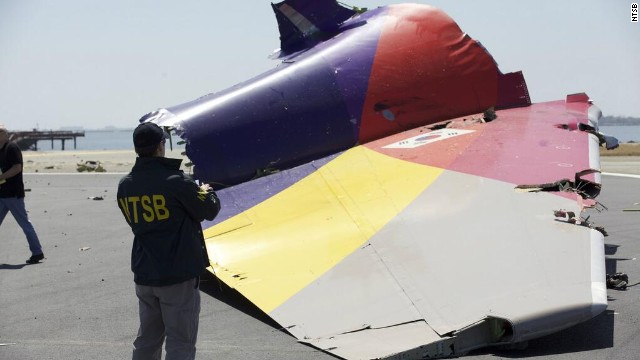 An investigator inspects the broken-off tail of the plane in a handout photo released July 7. The crash killed two people, injured 182 and forced the temporary closure of one of the country's largest airports.
An investigator inspects the broken-off tail of the plane in a handout photo released July 7. The crash killed two people, injured 182 and forced the temporary closure of one of the country's largest airports. 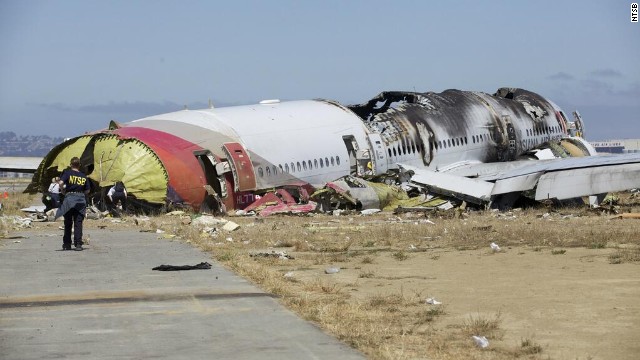 An investigator stands near the tail of the plane in a handout photo released on July 7. The NTSB has ruled out weather as a problem and said that conditions were right for a "visual landing."
An investigator stands near the tail of the plane in a handout photo released on July 7. The NTSB has ruled out weather as a problem and said that conditions were right for a "visual landing." 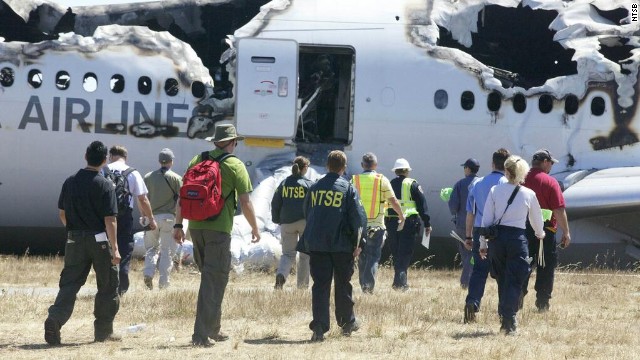 Investigators approach the crash in a handout photo released on July 7.
Investigators approach the crash in a handout photo released on July 7. 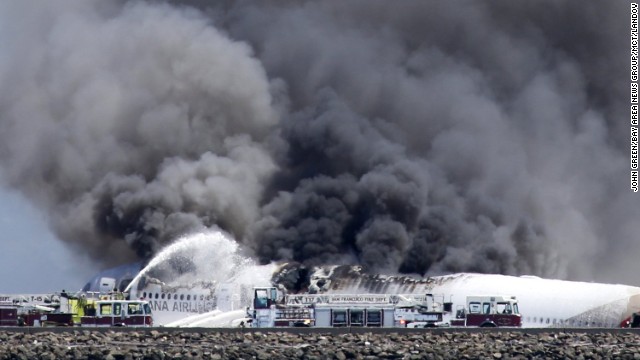 Fire crews attempt to quench the blaze on Saturday, July 6.
Fire crews attempt to quench the blaze on Saturday, July 6. 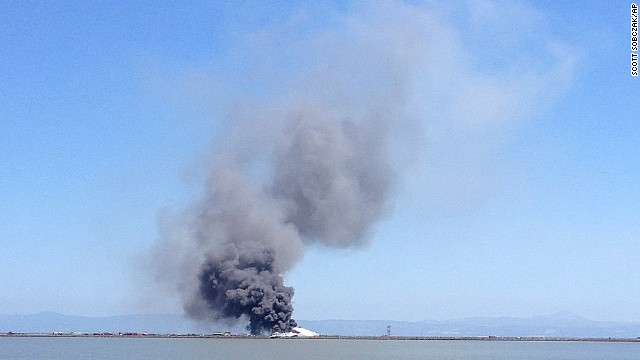 Smoke rises from the crash site across the San Francisco Bay on July 6.
Smoke rises from the crash site across the San Francisco Bay on July 6.  Asiana Airlines Flight 214 remains on the runway on July 6.
Asiana Airlines Flight 214 remains on the runway on July 6. 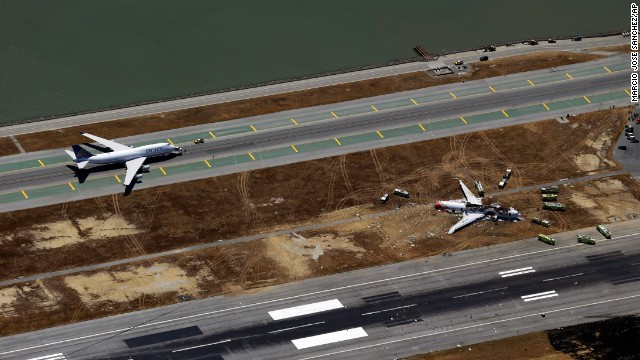 A plane sits on the runway on July 6 while emergency crews tend to the crash site.
A plane sits on the runway on July 6 while emergency crews tend to the crash site. 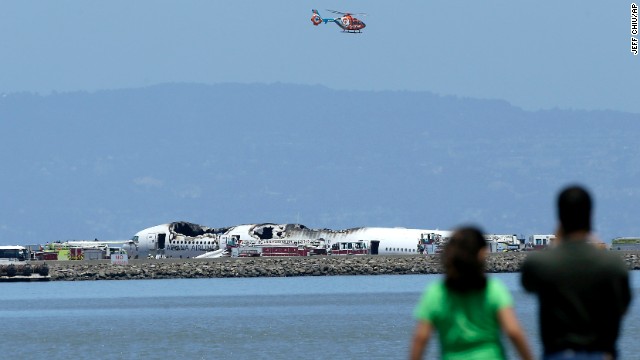 A helicopter flies above the wreckage on July 6 as people observe from across the waters of San Francisco Bay.
A helicopter flies above the wreckage on July 6 as people observe from across the waters of San Francisco Bay. 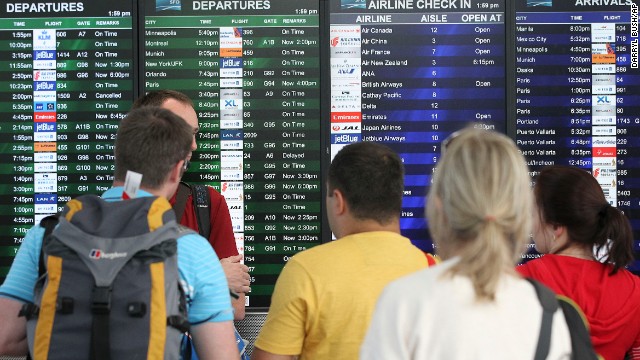 Travelers at San Francisco International Airport look at the departures and arrivals board after Asiana Flight 214 crashed on July 6. The airport, located 12 miles south of downtown San Francisco, is California's second busiest, behind Los Angeles International.
Travelers at San Francisco International Airport look at the departures and arrivals board after Asiana Flight 214 crashed on July 6. The airport, located 12 miles south of downtown San Francisco, is California's second busiest, behind Los Angeles International.  Kevin Cheng talks on his phone as he waits in the terminal after Asiana Airlines Flight 214 crash-landed on July 6. He said he was supposed to pick up students who were on board the flight from Seoul.
Kevin Cheng talks on his phone as he waits in the terminal after Asiana Airlines Flight 214 crash-landed on July 6. He said he was supposed to pick up students who were on board the flight from Seoul. 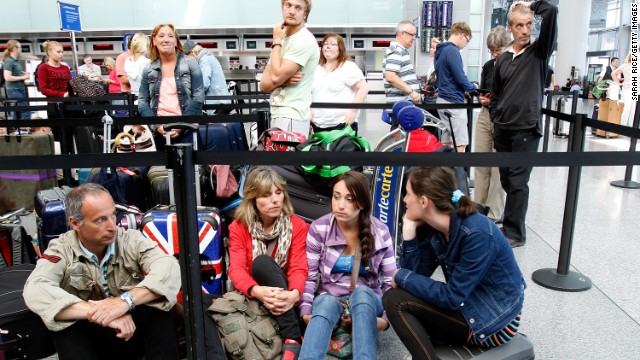 Passengers wait for the British Airways counter to reopen at San Francisco International Airport on July 6.
Passengers wait for the British Airways counter to reopen at San Francisco International Airport on July 6. 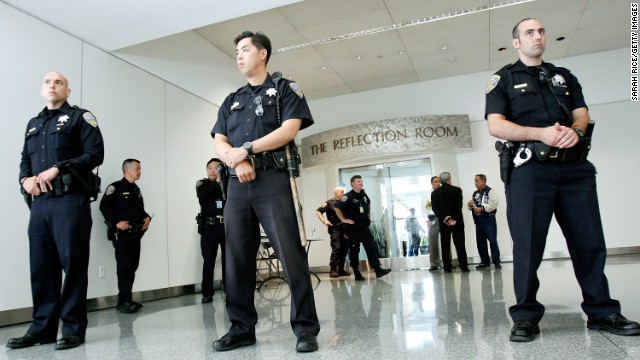 Police guard the Reflection Room at the San Francisco airport's international terminal, where passengers from Asiana Airlines Flight 214 were reportedly gathering after the crash landing on July 6.
Police guard the Reflection Room at the San Francisco airport's international terminal, where passengers from Asiana Airlines Flight 214 were reportedly gathering after the crash landing on July 6. 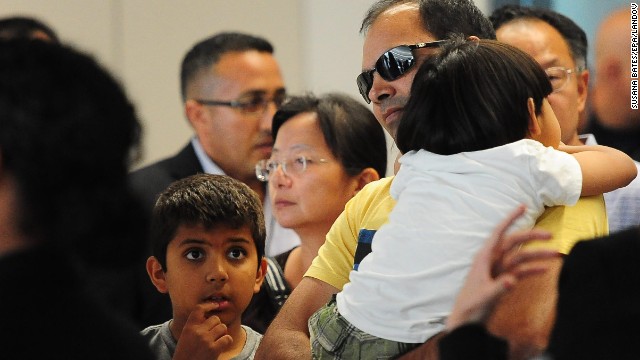 People are escorted from the Reflection Room at the San Francisco International Airport on July 6.
People are escorted from the Reflection Room at the San Francisco International Airport on July 6. 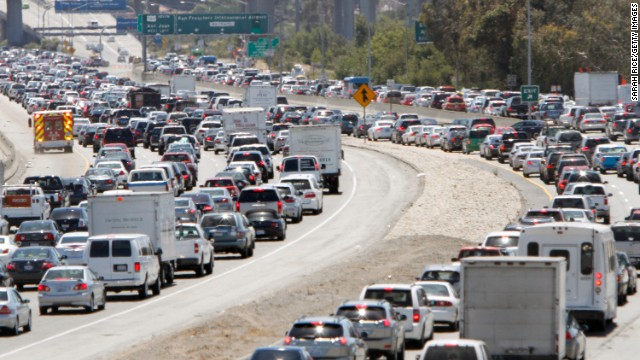 Traffic backs up on U.S. Route 101 South in San Francisco on July 6. The Bay Area airport was closed to incoming and departing traffic after the crash, according to the Federal Aviation Administration.
Traffic backs up on U.S. Route 101 South in San Francisco on July 6. The Bay Area airport was closed to incoming and departing traffic after the crash, according to the Federal Aviation Administration. 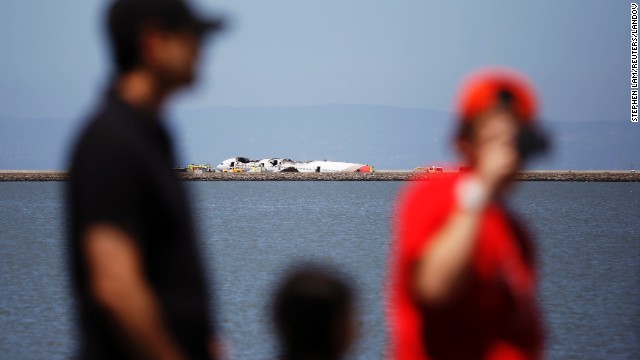 People look over the wreckage across a cove in San Francisco Bay on July 6.
People look over the wreckage across a cove in San Francisco Bay on July 6. 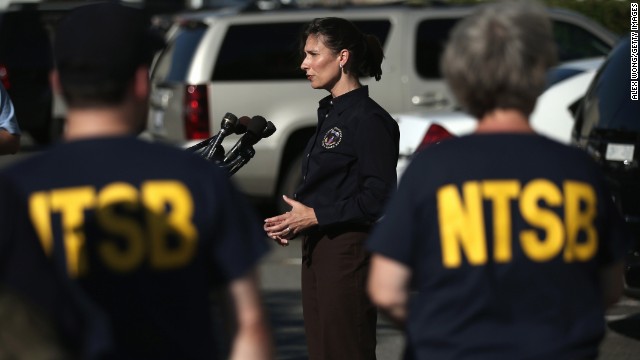 Deborah Hersman, chairwoman of the National Transportation Safety Board, speaks to the press at Reagan National Airport in Arlington, Virginia, before departing for San Francisco with an NTSB crew on July 6 to investigate the crash site.
Deborah Hersman, chairwoman of the National Transportation Safety Board, speaks to the press at Reagan National Airport in Arlington, Virginia, before departing for San Francisco with an NTSB crew on July 6 to investigate the crash site. 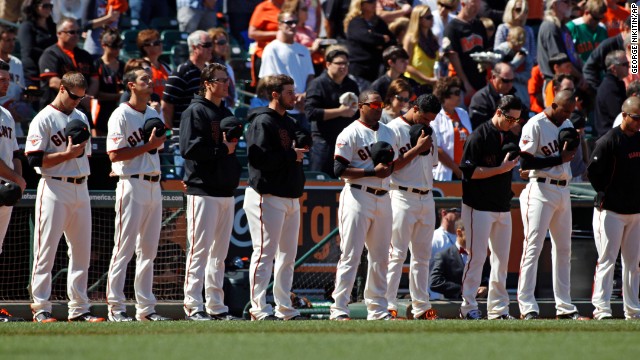 The San Francisco Giants observe a moment of silence for those killed and hurt in the crash before their baseball game on July 6 against the Los Angeles Dodgers at AT&T Park in San Francisco.
The San Francisco Giants observe a moment of silence for those killed and hurt in the crash before their baseball game on July 6 against the Los Angeles Dodgers at AT&T Park in San Francisco. 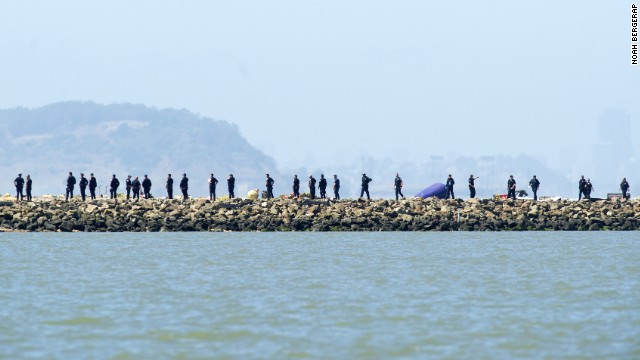 Crews comb the end of a San Francisco airport runway following the crash landing on July 6.
Crews comb the end of a San Francisco airport runway following the crash landing on July 6. 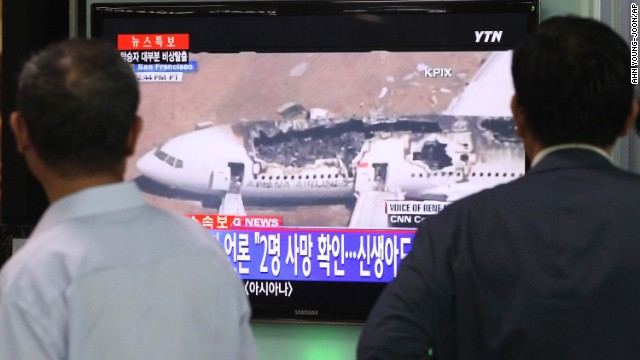 People in Seoul watch a news program reporting about the crash landing on July 6 in San Francisco. Asiana Airlines Flight 214 took off from Seoul earlier Saturday.
People in Seoul watch a news program reporting about the crash landing on July 6 in San Francisco. Asiana Airlines Flight 214 took off from Seoul earlier Saturday. 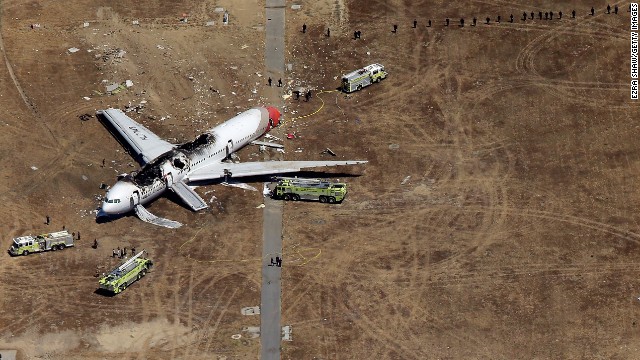 The plane crashed on July 6 around 11:30 a.m. (2:30 p.m. ET).
The plane crashed on July 6 around 11:30 a.m. (2:30 p.m. ET). 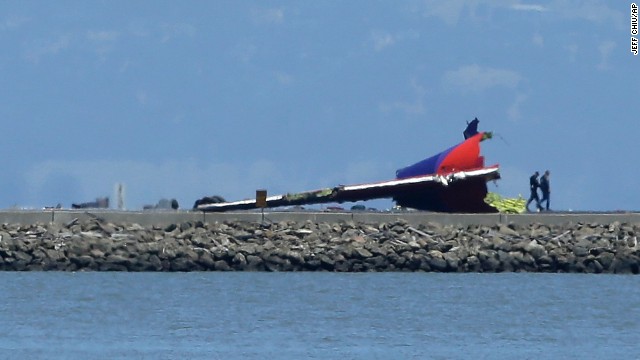 People walk past the wreckage of the plane's tail on July 6.
People walk past the wreckage of the plane's tail on July 6. 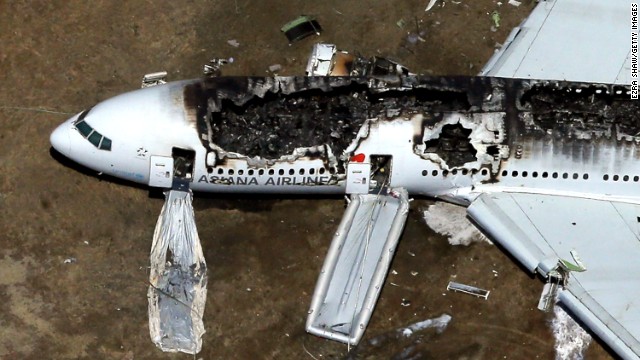 The burned-out plane remains on the runway on July 6. Passengers and crew members escaped down the emergency inflatable slides.
The burned-out plane remains on the runway on July 6. Passengers and crew members escaped down the emergency inflatable slides. 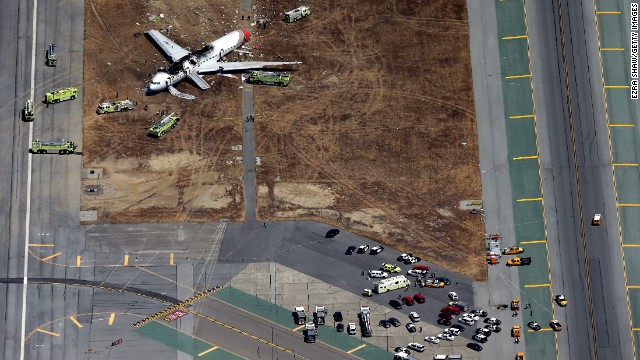 Rescue workers tend to the crash site on July 6.
Rescue workers tend to the crash site on July 6. 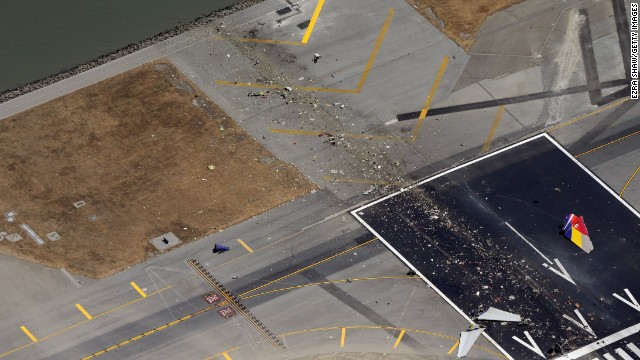 Debris litters the runway on July 6.
Debris litters the runway on July 6. 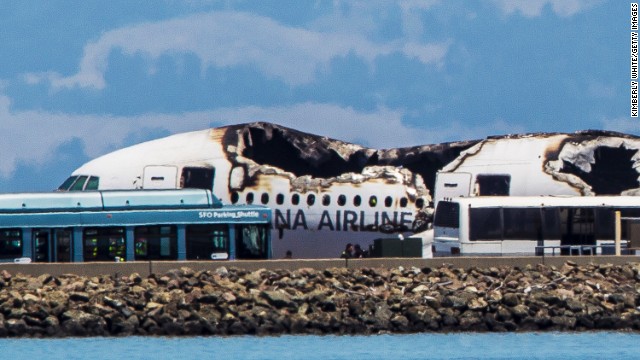 Airport shuttles arrive on the scene after the crash landing.
Airport shuttles arrive on the scene after the crash landing. 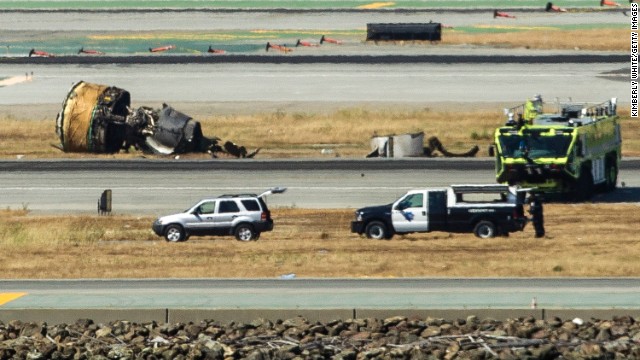 Wreckage from the Boeing 777 lies on the tarmac on July 6.
Wreckage from the Boeing 777 lies on the tarmac on July 6. 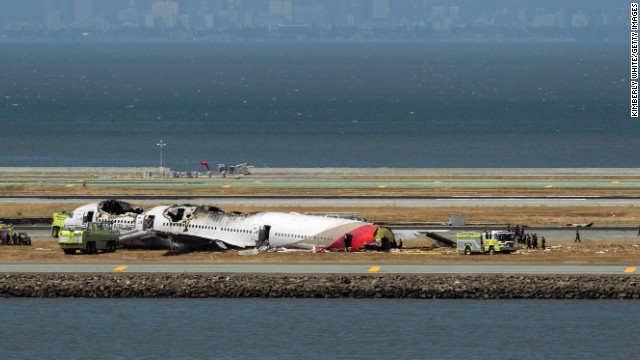 Crews surround the remains of the plane on July 6.
Crews surround the remains of the plane on July 6. 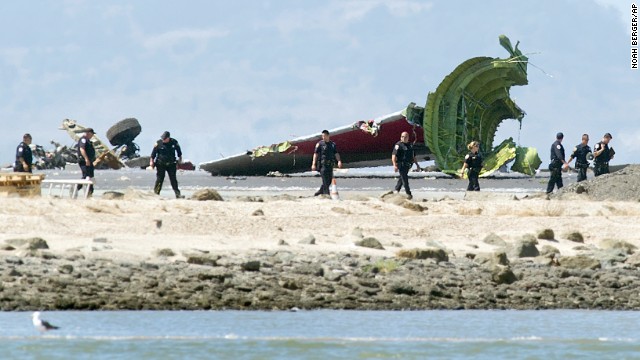 Investigators pass the detached tail and landing gear of Asiana Airlines Flight 214 on July 6.
Investigators pass the detached tail and landing gear of Asiana Airlines Flight 214 on July 6. 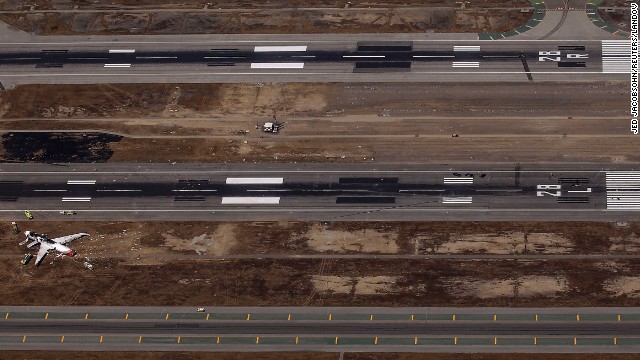 An aerial view shows the site of the crash landing between the runways on July 6.
An aerial view shows the site of the crash landing between the runways on July 6. 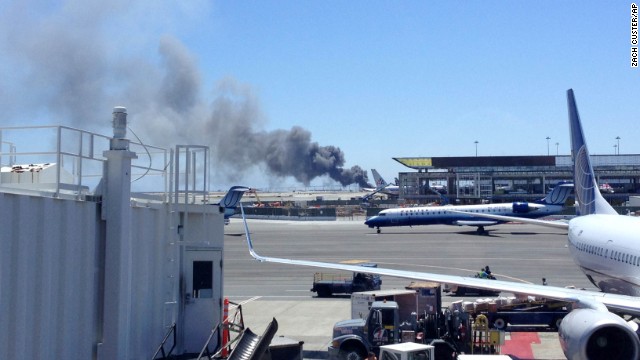 Smoke rises from the crash site on July 6 at the airport in San Francisco.
Smoke rises from the crash site on July 6 at the airport in San Francisco. 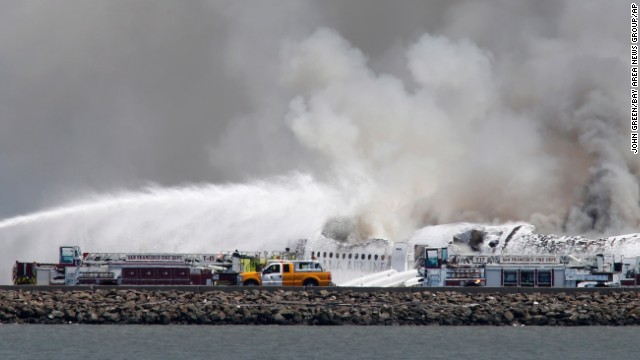 Fire crews work at the crash site at San Francisco International Airport on July 6.
Fire crews work at the crash site at San Francisco International Airport on July 6. 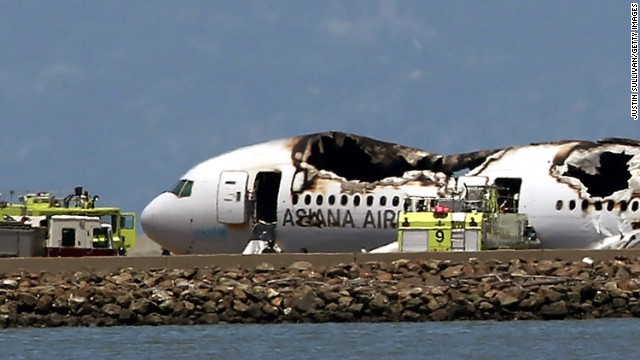 The Boeing 777 lies burned on the runway after it crashed landed on July 6.
The Boeing 777 lies burned on the runway after it crashed landed on July 6. 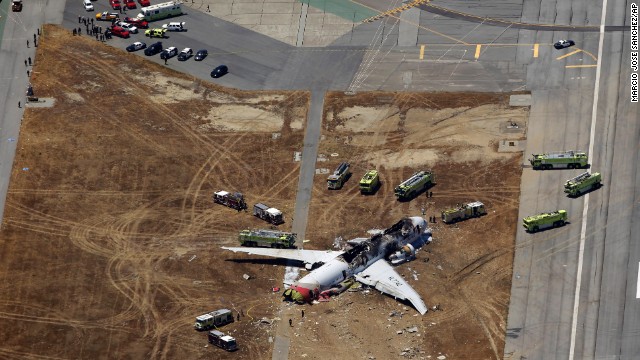 An aerial photo of the scene on July 6 shows the extent of the plane's damage.
An aerial photo of the scene on July 6 shows the extent of the plane's damage. 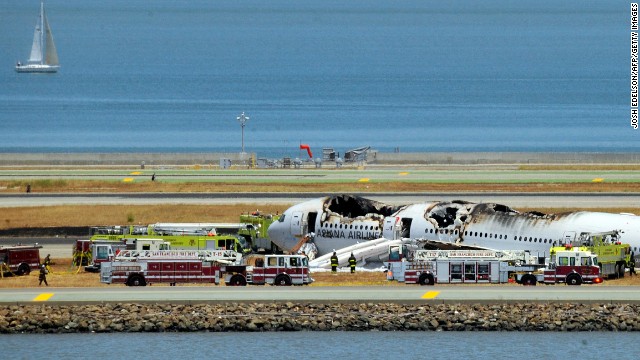 The burned-out plane sits surrounded by emergency vehicles on July 6.
The burned-out plane sits surrounded by emergency vehicles on July 6. 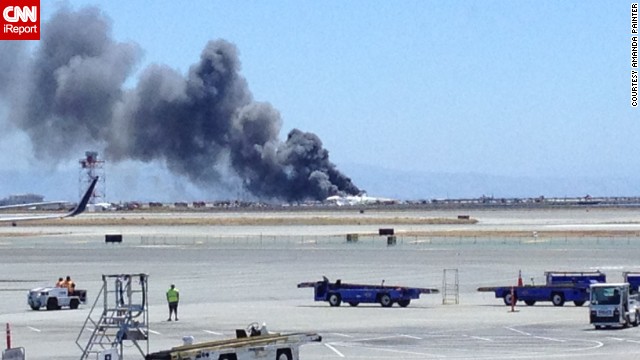 CNN iReporter Amanda Painter took this photo while waiting at the San Francisco airport on July 6. The entire airport has shut down and flights diverted to other airports.
CNN iReporter Amanda Painter took this photo while waiting at the San Francisco airport on July 6. The entire airport has shut down and flights diverted to other airports.  iReporter Val Vaden captured this photo while waiting in a departure lounge at the San Francisco airport on July 6. Val observed the billowing smoke and emergency responders' rush in.
iReporter Val Vaden captured this photo while waiting in a departure lounge at the San Francisco airport on July 6. Val observed the billowing smoke and emergency responders' rush in. 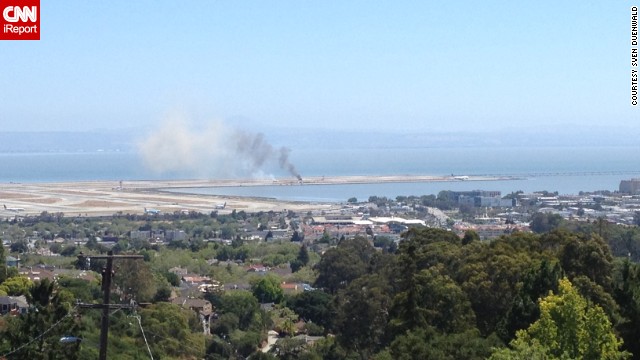 iReporter Sven Duenwald was at home on July 6 when he saw smoke rising into the air near the San Francisco International Airport.
iReporter Sven Duenwald was at home on July 6 when he saw smoke rising into the air near the San Francisco International Airport. 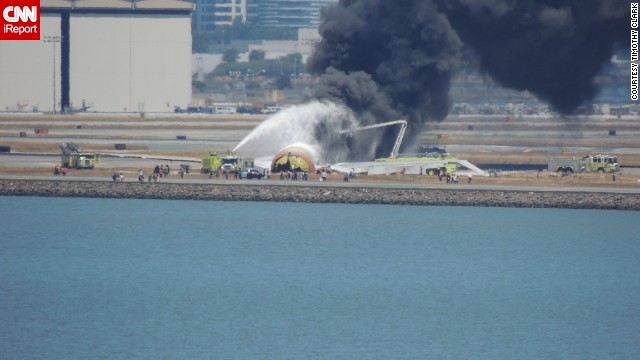 iReporter Timothy Clark was standing on the eighth floor of the Embassy Suites Airport Hotel when he heard a loud crashing sound from outside. "My daughter told me she heard a plane crash. I used my camera to get a clearer view and I could see a dust cloud. Then people running from the plane, then flames," he said.
iReporter Timothy Clark was standing on the eighth floor of the Embassy Suites Airport Hotel when he heard a loud crashing sound from outside. "My daughter told me she heard a plane crash. I used my camera to get a clearer view and I could see a dust cloud. Then people running from the plane, then flames," he said. 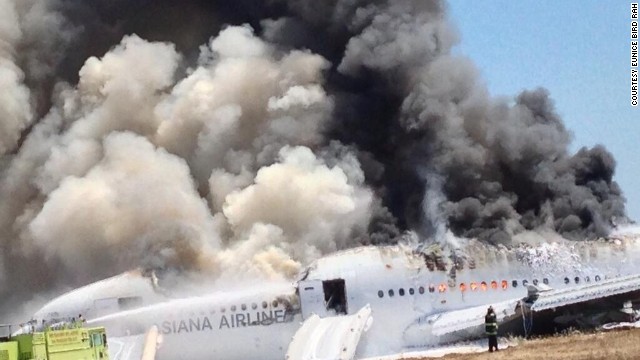 A photo provided to CNN by Eunice Bird Rah -- and shot by her father, who was a passenger on the plane -- shows flames and smoke bursting out of many of the aircraft's windows.
A photo provided to CNN by Eunice Bird Rah -- and shot by her father, who was a passenger on the plane -- shows flames and smoke bursting out of many of the aircraft's windows.  David Eun, a passenger on Asiana Airlines Flight 214, posted this image to Path.com along with the message, "I just crash landed at SFO. Tail ripped off. Most everyone seems fine, I'm ok. Surreal..." It was one of the first photographs taken after the crash.
David Eun, a passenger on Asiana Airlines Flight 214, posted this image to Path.com along with the message, "I just crash landed at SFO. Tail ripped off. Most everyone seems fine, I'm ok. Surreal..." It was one of the first photographs taken after the crash. 
1

2

3

4

5

6

7

8

9

10

11

12

13

14

15

16

17

18

19

20

21

22

23

24

25

26

27

28

29

30

31

32

33

34

35

36

37

38

39

40

41

42

43
- Arnold Barnett: Commercial flight fatalities rare, and most survived Asiana Flight 214 crash
- He says a U.S. youth more likely to be president or win Nobel Prize in physics than die in crash
- He says we must focus on mechanical reasons for crash
- Barnett: Seven-second warning of stall should have come sooner
Editor's note: Arnold Barnett is the George Eastman Professor of Management Science and professor of statistics at MIT's Sloan School of Management. An aviation safety expert, he has worked for the Federal Aviation Administration, Transportation Security Administration and two dozen airlines and airports. He was awarded the 2002 President's Citation from the Flight Safety Foundation for "truly outstanding contributions with respect to safety."
(CNN) -- I write this piece with some trepidation, because people are understandably troubled by the crash of Asiana Airlines Flight 214 and want to know why it happened. They do not want to hear that it "could have been worse," that such events are extremely rare or that the causes of the accident aren't clear. But I will focus below on all of these points, because they are true and worth noting.
It is tragic that two teenage girls perished in the Asiana crash. But given the conflagration that left the plane a charred hulk, it is remarkable that 99% of the passengers survived the accident. Moreover, these were the first two deaths on scheduled commercial flights in the United States this year or, for that matter, in the last 4½ years. During that period, more 3 billion passengers flew with no fatalities in the United States or on U.S. airlines. Two in 3 billion is a very small number.

How small? At that risk per flight, a traveler could on average fly once a day for 4 million years before succumbing to a fatal crash. An American youth at an airport is far more likely to grow up to be president than to perish on today's flight. (That youth is also more likely to win the Nobel Prize in physics.)
U.S. flying has become so safe that fear of an air journey is almost as farfetched as fear of a ceiling collapse at the grocery store. That circumstance is a remarkable tribute to the efforts of airlines, aircraft manufacturers, governments, the media and a flying public that holds aviation to the highest standards of safety.
Yet we should not tolerate even two deaths if they can plausibly be avoided. For that reason, we need to study carefully what went wrong on Asiana Flight 214 to minimize the risk of recurrence. We should resist the temptation to characterize what happened as pilot error, which can lead to the fatalistic view that "to err is human" and that these things are bound to happen. Even if the pilots did err in some way, the germane question is why.
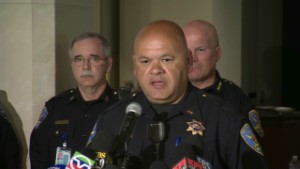 First responder: 'We had no time'
First responder: 'We had no time' 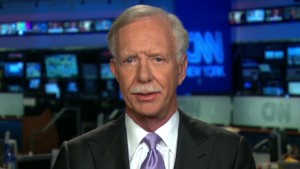 Hero pilot: 'There are always surprises'
Hero pilot: 'There are always surprises' 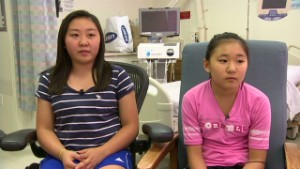 Young plane crash survivors speak
Young plane crash survivors speak It appears Asiana Flight 214's problem was that it was flying so slowly it eventually stalled and collapsed to the ground.
But why were the pilots unaware of the slow speed? Were some of the instrument readings faulty? Might some of the readings have been hard to interpret (like the confusing readings about the rate of descent that caused a jet to crash in 1992 into a mountain)?
The pilots did get a warning about an impending stall about seven seconds before the plane hit the sea wall. But why was there only a seven-second warning? Could systems be reconfigured so that warnings about potential stalls are issued sooner? To be sure, earlier warnings might yield a proliferation of false alarms, but might that price be worth paying so that true alarms arrive in time to be useful? Had Asiana Flight 214 been warned seven seconds earlier, we might never have heard about it.
Under the circumstances, it is heartening that the National Transportation Safety Board will painstakingly study everything that happened on Asiana Flight 214, and will identify indirect as well as direct causes of the crash. That is the best reason to hope that what happened at San Francisco International Airport will never occur again within our lifetimes. And given all the progress to date in aviation safety, that hope is anything but forlorn.
Follow @CNNOpinion on Twitter .
Join us at Facebook/CNNOpinion .
The opinions expressed in this commentary are solely those of Arnold Barnett.







